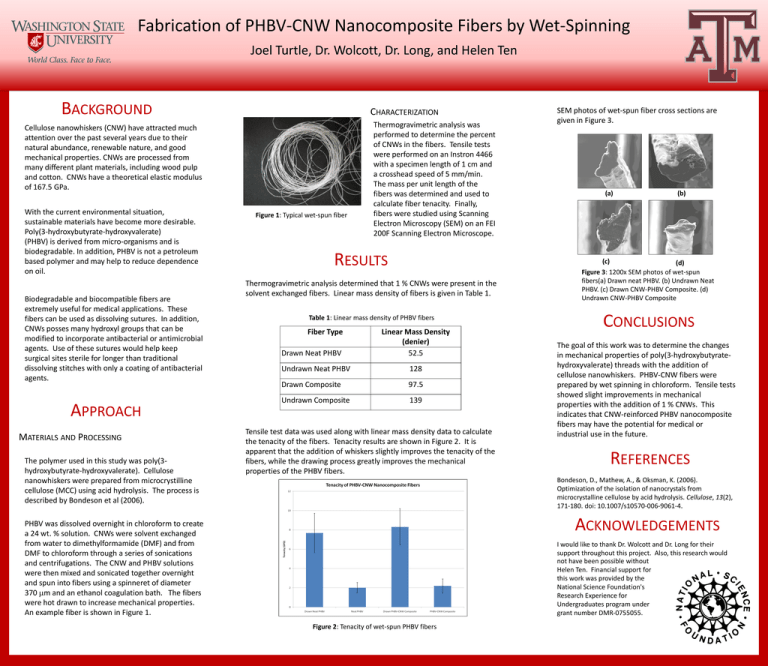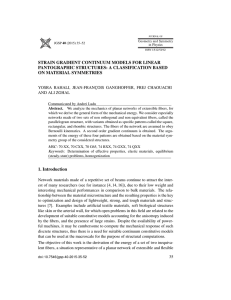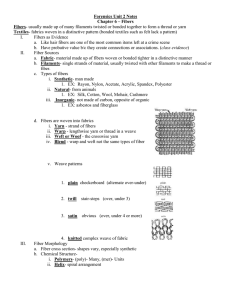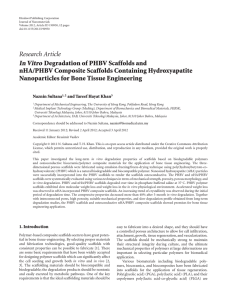B Fabrication of PHBV-CNW Nanocomposite Fibers by Wet-Spinning ACKGROUND
advertisement

Fabrication of PHBV-CNW Nanocomposite Fibers by Wet-Spinning Joel Turtle, Dr. Wolcott, Dr. Long, and Helen Ten BACKGROUND CHARACTERIZATION Cellulose nanowhiskers (CNW) have attracted much attention over the past several years due to their natural abundance, renewable nature, and good mechanical properties. CNWs are processed from many different plant materials, including wood pulp and cotton. CNWs have a theoretical elastic modulus of 167.5 GPa. With the current environmental situation, sustainable materials have become more desirable. Poly(3-hydroxybutyrate-hydroxyvalerate) (PHBV) is derived from micro-organisms and is biodegradable. In addition, PHBV is not a petroleum based polymer and may help to reduce dependence on oil. Biodegradable and biocompatible fibers are extremely useful for medical applications. These fibers can be used as dissolving sutures. In addition, CNWs posses many hydroxyl groups that can be modified to incorporate antibacterial or antimicrobial agents. Use of these sutures would help keep surgical sites sterile for longer than traditional dissolving stitches with only a coating of antibacterial agents. APPROACH MATERIALS AND PROCESSING The polymer used in this study was poly(3hydroxybutyrate-hydroxyvalerate). Cellulose nanowhiskers were prepared from microcrystilline cellulose (MCC) using acid hydrolysis. The process is described by Bondeson et al (2006). Figure 1: Typical wet-spun fiber Thermogravimetric analysis was performed to determine the percent of CNWs in the fibers. Tensile tests were performed on an Instron 4466 with a specimen length of 1 cm and a crosshead speed of 5 mm/min. The mass per unit length of the fibers was determined and used to calculate fiber tenacity. Finally, fibers were studied using Scanning Electron Microscopy (SEM) on an FEI 200F Scanning Electron Microscope. RESULTS Table 1: Linear mass density of PHBV fibers Drawn Neat PHBV (a) (b) (c) Thermogravimetric analysis determined that 1 % CNWs were present in the solvent exchanged fibers. Linear mass density of fibers is given in Table 1. Fiber Type SEM photos of wet-spun fiber cross sections are given in Figure 3. Linear Mass Density (denier) 52.5 Undrawn Neat PHBV 128 Drawn Composite 97.5 Undrawn Composite 139 Tensile test data was used along with linear mass density data to calculate the tenacity of the fibers. Tenacity results are shown in Figure 2. It is apparent that the addition of whiskers slightly improves the tenacity of the fibers, while the drawing process greatly improves the mechanical properties of the PHBV fibers. (d) Figure 3: 1200x SEM photos of wet-spun fibers(a) Drawn neat PHBV. (b) Undrawn Neat PHBV. (c) Drawn CNW-PHBV Composite. (d) Undrawn CNW-PHBV Composite CONCLUSIONS The goal of this work was to determine the changes in mechanical properties of poly(3-hydroxybutyratehydroxyvalerate) threads with the addition of cellulose nanowhiskers. PHBV-CNW fibers were prepared by wet spinning in chloroform. Tensile tests showed slight improvements in mechanical properties with the addition of 1 % CNWs. This indicates that CNW-reinforced PHBV nanocomposite fibers may have the potential for medical or industrial use in the future. REFERENCES Bondeson, D., Mathew, A., & Oksman, K. (2006). Optimization of the isolation of nanocrystals from microcrystalline cellulose by acid hydrolysis. Cellulose, 13(2), 171-180. doi: 10.1007/s10570-006-9061-4. ACKNOWLEDGEMENTS PHBV was dissolved overnight in chloroform to create a 24 wt. % solution. CNWs were solvent exchanged from water to dimethylformamide (DMF) and from DMF to chloroform through a series of sonications and centrifugations. The CNW and PHBV solutions were then mixed and sonicated together overnight and spun into fibers using a spinneret of diameter 370 m and an ethanol coagulation bath. The fibers were hot drawn to increase mechanical properties. An example fiber is shown in Figure 1. I would like to thank Dr. Wolcott and Dr. Long for their support throughout this project. Also, this research would not have been possible without Helen Ten. Financial support for this work was provided by the National Science Foundation's Research Experience for Undergraduates program under grant number DMR-0755055. Figure 2: Tenacity of wet-spun PHBV fibers





